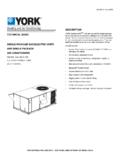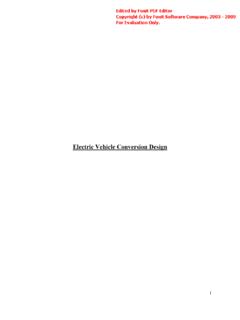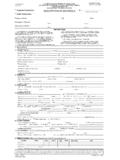Transcription of General Electric CF34 Engine - MrMoo
1 SINGLE STAGE FANBYPASS RATIO :1 SPINNERFAN BLADECONTAINMENT CASINGACCESSORYGEAR BOXFAN VANE14 STAGEHIGH PRESSUREAXIAL COMPRESSORFLOW THROUGHANNULARCOMBUSTION4 STAGELOW PRESSURETURBINE2 STAGEHIGH PRESSURETURBINEG eneral Electric cf34 EngineChallenger 601 Developed for Training PurposesNovember 19974-175 PowerplantCAE SimuFlite4-176 Developed for Training PurposesChallenger 601 November 1997 Challenger 601 Developed for Training PurposesNovember 1997 Engine Oil SystemOIL TANK21675432 ACCESSORYGEARBOXORIFICEHEATEXCHANGERFILT ER ELEMENTBYPASS VALVERELIEF VALVECHECKVALVEFUELIMPENDINGBYPASSSENSOR LUBE AND SCAVENGEPUMP ASSEMBLYELECTRICMASTER CHIPDETECTORDRAINPORTSCAVENGE SCREENS(8 PLACES)A-SUMPSCAVENGEPUMPTANK PRESSURERELIEF VALVEDEAERATORSUPPLY OILSCAVENGE OILVENTCHIP DETECTOR,INSTALLED ON 1A/3A.
2 OPTIONAL ON 3 RPRESSURETRANSMITTER1C-SUMP6 & 7 BEARINGB-SUMP4 & 5 BEARINGA-SUMP1, 2 & 3 BEARINGOIL LEVEL PROBEOIL TEMP PROBESCAVENGEELEMENTS(6)PRESSUREELEMENT1 111B-SUMPVENT AIRREGULATINGVALVE1114-177 PowerplantCAE SimuFlite4-178 Developed for Training PurposesChallenger 601 November 1997 FUELHEATER14 STAGEBLEED AIRVGVGTOECOLOGICALDRAINTOECOLOGICALSYST EMSTATORVANESN2 SPEEDGOVERNINGPLAOILCOOLERBYPASSSIGNALAM PLIFIERFUELDISTRIBUTORECOLOGICALDRAINTAN KN1T2N2N1 SPEEDCONTROLOILINOILOUTFUELBYPASFUEL PUMPPRIMARYHIGH PRESSUREELEMENTFUEL PUMPSECONDARYHIGH PRESSUREELEMENT18 FUELINJECTORSDRAINVALVCHECKVALVEFUEL PUMPLOW PRESSELEMENTFIREWALLSHUTOFFVALVEMAIN FUEL CONTROLINLETGUIDEVANESFEEDBACKTO MAINEJECTORMOTIVE FLOWENGINE BOOST PRESSUREPUMP DISCHARGE PRESSURESERVO PRESSUREFUEL CONTROL DISCHARGEPRESSUREMECHANICAL CONNECTIONOILCOOLERTORQUEMOTORFUEL TEMPLR04008002000300035004000 FUEL2006001000 PPx10 FUEL FLOWC
3 LRFUEL6040200-206040200-207070 BYPASSFLOWRELIEFVALVEVALVEFILTERP3 T2CN2 Engine Fuel SystemGE cf34 -1A/-3 APowerplantChallenger 601 Developed for Training Purposes4-179 November 1997 VGVGFUEL TEMPP3 T2CN2 STATORVANESN2 SPEEDGOVERNINGPLALR040080020003000350040 00 FUEL2006001000 PPx10 FUEL FLOWC LRSIGNALAMPLIFIERTORQUEMOTORN1T2N2N1 SPEEDCONTROLFUELBYPASFUEL PUMPPRIMARYHIGHPRESSUREELEMENTFUEL PUMPSECONDARYHIGH PRESSUREELEMENT18 FUELINJECTORSFIREWALLSHUTOFFVALVEMAIN FUEL CONTROLINLETGUIDEVANESFEEDBACKMOTIVE FLOWENGINE BOOST PRESSUREPUMP DISCHARGE PRESSURESERVO PRESSUREFUEL CONTROL DISCHARGEPRESSUREMECHANICAL CONNECTIONOILOUTOILINHEATEXCHANGERBYPASS FLOWFUEL8060400-408060400-40120120 RELIEFVALVEO/BDRAINO/BDRAINO/BDRAINVALVE FILTERE ngine Fuel SystemGE cf34 -3A1 CAE SimuFlite4-180 Developed for Training PurposesChallenger 601 November 1997 PowerplantChallenger 601 Developed for Training Purposes4-181 November 1997 PowerplantTwo General Electric cf34 turbofan engines power the CanadairChallenger CL-601-1A/-3A/3R aircraft (see Table 4-N).
4 CL-601-1 ACF34-1 ACF34-3A/-3A2CL-601-3 ACF34-3 ACF34-3A2CL-601-3 RCF34-3A1N/ATable 4-N; Engine InstallationModelStandardOptionalThe GE cf34 turbofan, developed from the GE TF34 used onthe Republic A-10 and Lockheed S-3, is an efficient and quietengine that has a :1 bypass cf34 -1A Engine produces approximately 8,650 lbs of sta-tic takeoff thrust. An automatic performance reserve (APR)system provides 9,140 lbs of static takeoff thrust, an addition of490 lbs, from the operating Engine , if the other Engine losespower or cf34 -3A/-3A2/-3A1 engines produce approximately 8,729lbs of static takeoff thrust. These engines APR systems pro-vide 9,220 lbs of static thrust, an addition of 490 lbs from theoperating Engine , if the other Engine loses power or Engine construction consists of six major sections toease field maintenance and component replacement or six sections include: fan accessory compressor combustion high pressure (HP) turbine low pressure (LP) for Training PurposesChallenger 601 November 1997 The Engine s two-stage HP turbine (N2spool) drives the 14-stage axial compressor; the four-stage LP turbine (N1spool)drives the single-stage front fan.
5 Variable geometry inlet guidevanes (IGVs) behind the front fan control Engine core air flow toprevent compressor stalling and air enters the Engine inlet, the front fan accelerates air rear-ward toward the fan nozzle axial compressor. Approximately85% of the air bypasses the Engine core and exhausts over-board as thrust through the fan nozzle. The remaining 15%enters the Engine core. Essentially, the fan provides most of thethrust produced by the entering the compressor, air passes through the vari-able geometry IGVs. Controlled by two hydraulic (fuel) actua-tors, the IGV and five additional stages of variable geometrystator vanes open and close as a unit to regulate air flow intothe 14-stage compressor. As air flows through the compressor, it is progressively com-pressed and heated as its volume decreases.
6 The compressedand heated air then enters the combustion section where itmixes with fuel. During Engine start, two igniter plugs ignite thefuel/air mixture. After the Engine is running, the combustionprocess is hot, high velocity gas stream exiting the combustion sec-tion first flows through the two-stage HP turbine. The turbineextracts energy from the gas stream as it rotates to drive theaxial compressor. The gas stream then passes through thefour-stage LP turbine to drive the forward , the combustion by-products exit through the coreexhaust SimuFlitePowerplantChallenger 601 Developed for Training Purposes4-183 November 1997 Powerplant SystemsPowerplant systems include: lubrication ignition starting fuel and fuel control Engine oil pump s single pressure element draws oil from the oiltank to provide it under pressure through a filter.
7 If the filterbegins clogging, a bypass valve routes oil past the filter. If thefilter begins clogging and differential pressure between the filterinlet and outlet reaches 21 to 26 PSID, the impending bypasssensor illuminates an indicator on the aft circuit breaker distrib-ution the filter, oil flows through a check valve to the oil/fuelheat exchanger. As it flows through the heat exchanger, the oilgives up heat to the relatively cooler fuel. After passing throughthe heat exchanger, the oil flow splits into a low and high pres-sure circuit. The low pressure circuit supplies the No. 1, 2, and3 bearings (A sump) and the accessory gearbox. The high pres-sure circuit supplies the No. 4 and 5 bearings (B sump) and theNo. 6 and 7 bearings (C sump).After lubricating, cleaning, and cooling the Engine , the oilpump s scavenge elements draw oil from the accessory gear-box and B and C sumps.
8 Oil from the A sump normally gravityflows to the accessory gearbox. During climbs and descents,the A sump scavenge pump draws oil from the A sump and thenreturns it to the oil tank. A cyclone-type de-aerator removesentrapped air from the oil. On the cf34 -3A1 Engine , the oiltank has a sight for Training PurposesChallenger 601 November 1997 Downstream of the fuel/oil heat exchanger, a tapping providespressurized oil to the oil pressure transmitter and low oil pres-sure switch. If oil pressure drops to 28 3 PSI ( cf34 -1A/-3A/-3A2) or 35 PSI ( cf34 -3A1), the pressure switch illuminates theappropriate OIL PRESS gage LOP (low oil pressure) light. Atemperature bulb in the oil tank drives the OIL TEMP detectors at strategic points in the oil scavenge lines andtank monitor Engine wear.
9 If sufficient ferrous particles accu-mulate on a chip detector, the particles bridge the detector scontacts. During routine maintenance, a continuity check ofeach detector provides an indication of Engine wear and possi-ble mechanical oil replenishment system allows Engine oil tank refilling with-out opening the Engine cowls. The system consists of an oilreplenishment tank, Electric oil pump, two oil level probes andsignal conditioner, oil level control panel, and a selector but the oil level probes are in the rear equipment the power switch in the ON position illuminates the ONlight and supplies 28V DC to the selector valve. Selecting eitherL or R energizes the oil pump and directs oil from the replen-ishment tank to the selected Engine s oil tank. When Engine oiltank level reaches full, the associated LH or RH switchlight illu-minates.
10 Placing the selector valve in the OFF position de-ener-gizes the Electric oil pump. Selecting the power switch to OFFcuts power to the selector cf34 -1A and -3A engines have a dual-circuit ignitionexciter while the cf34 -3A2 and -3A1 engines have two single-circuit ignition SimuFlitePowerplantChallenger 601 Developed for Training Purposes4-185 January 1999 Pressing the IGN A/ON and/or IGN B/ON switchlight arms theignition system; the switchlight illuminates green. The A ignitionsystem receives 115V AC directly from the AC electrical sys-tem. The B system receives 115V AC from a DC-powered sta-tic a START button begins the Engine start sequence bysupplying power through the STOP switch contacts to the startlatch and bleed air relays. The green START light the start latch relay closes, the ignition system relaycloses to supply power to the ignition exciter(s).





